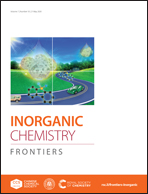Hydrophobic tail length in spin crossover active iron(ii) complexes predictably tunes T½ in solution and enables surface immobilisation†
Abstract
The literature tetradentate acyclic Schiff base ligand HLH-OH (from the 2 : 1 reaction of pyridine-2-carboxylaldehyde with 1,3-diamino-2-propanol) was alkylated using a range of 1-bromoalkanes varying in length, BrR (R = C10H21, C16H33, C18H37, C20H41 and C22H45) to yield five new ligands, LH-OR. The synthesis, magnetic and Langmuir characteristics of the corresponding family of six neutral mononuclear Fe(II) complexes, the parent complex [FeII(HLH-OH)(NCBH3)2] and the five alkylated ligand derivatives [FeII(LH-OR)(NCBH3)2], is detailed. The solution spin crossover temperature, T½, can be tuned by two methods: (a) increasing the solvent polarity index (P′) from 5 to 7 increases T½ by 172 K, whereas (b) increasing the tail length from C10 to C22 decreases T½ by 115 K. In both cases strong linear correlations are observed, so both of these, choice of solvent (R2 = 0.99, albeit only for three solvents) and of tail length (R2 = 0.98, for five complexes), are levers for the predictable tuning of the spin state in advance of synthesis. The compounds with longer tails, C18, C20 and C22, showed a small window of thermal hysteresis (<5 K) in D3-acetonitrile solution. Water solubility hampered the formation of Langmuir films of these complexes. But the use of a 1 : 1 mixture of stearic acid with [FeII(LH-OC18)(NCBH3)2] facilitated the formation of a stable Langmuir film, a monolayer of which was transferred onto a quartz slide: multi-layering was not possible.



 Please wait while we load your content...
Please wait while we load your content...